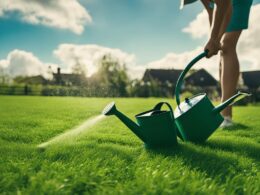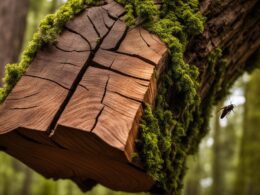As the sun shines a bit warmer and your yard beckons for outdoor activities, your idyllic space could be home to a hidden menace: yellow jackets. Known for their distinctive black and yellow markings, these territorial insects often create nests that go unnoticed until a close and unfortunate encounter. As a homeowner in the United States, understanding the essentials of yellow jacket eradication can transform your yard back into the safe haven it’s meant to be, especially during the height of their activity in the late summer and early fall.
Being proactive with wasp nest removal is more than a convenience—it’s a safety measure. Whether by strategically employing outdoor pest control techniques or by safely exterminating yellow jackets, the approach to handling these pests is a delicate one. As female yellow jackets can sting repeatedly, often to defend their nests, pinpointing and addressing these hotspots effectively requires both caution and correct methods.
Key Takeaways
- Identifying yellow jacket nests early can prevent potential stings and disruptions to your outdoor activities.
- Employing professional pest control services can be a safe and effective solution for wasp nest removal.
- Utilize insecticidal dust or liquid treatments at night for a stealthier approach to exterminating yellow jackets.
- Homemade traps can serve as an initial measure to reduce yellow jacket populations but might not eliminate the problem entirely.
- Familiarize yourself with safe application methods of aerosol insecticides if opting for a DIY wasp nest removal.
- Keep in mind the increased potential for allergic reactions during yellow jacket eradication efforts and plan accordingly.
Here Is How To Kill Yellow Jacket Nest In Your Yard
Confronted with the need to destroy yellow jacket nest in your yard? You are not alone. These stinging pests present a troubling predicament for homeowners, making the extermination process a high priority when they nest in close proximity to human activity. Depending on the nest’s location and size, different methods are appropriate for addressing this unwanted infestation.
One of the most effective options for ensuring long-term relief is to hire professional exterminators. This route guarantees safety and efficacy but may impact your budget more than other methods. For immediate results, over-the-counter aerosol insecticides and freezing sprays are available to eliminate wasp infestation, especially when applied during dawn or dusk when yellow jackets are less active.
Here are some recommended strategies for yellow jacket extermination:
- Insecticidal Dust: Works best for ground nests and should be applied at night.
- Diatomaceous Earth: A natural, yet slower solution, more suitable for environmental enthusiasts.
- Homemade Traps: With sweet bait, these can reduce yellow jacket numbers but may not exterminate the entire nest.
- Non-Toxic Liquid Solution: Mixing dishwashing detergent with water can suffocate wasps in smaller infestations.
- Liquid Insecticides: Offer rapid results but should be handled with caution due to the chemical content.
To provide you a clearer idea, consider the following table that outlines the pros and cons of common yellow jacket eradication methods:
| Method | Target | Application | Environment | Effectiveness |
|---|---|---|---|---|
| Professional Extermination | All Nests | Professional Service | – | High |
| Aerosol Insecticides | Aerial Nests | DIY | Chemicals | Immediate |
| Insecticidal Dust | Ground Nests | Nightly DIY | Mild Chemicals | High |
| Diatomaceous Earth | Ground Nests | DIY | Eco-Friendly | Moderate |
| Homemade Traps | All Nests | DIY | Non-Toxic | Moderate |
| Dish Soap Solution | Small Infestations | DIY | Eco-Friendly | Variable |
| Liquid Insecticides | All Nests | DIY | Harsh Chemicals | Immediate |
Regardless of your chosen method, it is critical to prioritize your safety and the safety of those around you. Remember to wear proper protective clothing and carry out the extermination during the wasps’ dormant hours to minimize risks.
The Hazards of Yellow Jackets in Your Landscape
The serene ambiance of your backyard can quickly be disrupted by the sudden buzz of yellow jacket danger. These winged menaces can transform a leisurely summer into a season fraught with wasp sting risks. As their quest for nourishment becomes more desperate, and thus their temperament more volatile, understanding the risks and behaviors of yellow jackets is paramount in managing their insect menace.
Understanding the Threat of Yellow Jackets
Yellow jackets, a species known for their territorial instincts, can distinguish a perceived threat from mere proximity. Their willingness to use their stingers poses a considerable risk, especially when one encounters a hidden nest unawares. Not only do yellow jackets administer painful stings, but they also carry the potential for severe allergic reactions, highlighting the importance of a timely pest hazard assessment. Unlike their more docile bee relatives, yellow jackets can sting repeatedly, a feature that makes accidental encounters with their nests a 4-fold risk.
Seasonal Activity and Aggressive Behavior
As autumn approaches and food becomes scarce, yellow jackets’ search for sustenance leads them closer to human habitats – invading picnics, barbecues, and outdoor trash receptacles. Their aggression escalates, with the cooler months seeing a peak in wasp seasonal aggressionfall wasp activity correlates with the lifecycle of their colonies, as they fight to feed their young and sustain their queen.
Identifying Nesting Sites to Ensure Safety
Your ability to spot the hidden sanctuaries of these stinging insects is your first line of defense. Yellow jackets exhibit a preference for seclusion, constructing their nests in places like underground burrows, dense shrubberies, or within the quiet recesses of an attic or shed. Stay observant for the tell-tale signs of inhabitance, such as steady streams of yellow jackets entering and exiting through small holes or hovering near structural gaps. Early detection through locating yellow jacket nests and wasp nest identification is not just a proactive step towards removal; it’s a critical aspect of ensuring outdoor safety.
Preemptive Measures to Deter Yellow Jacket Colonization
As you relish the comfort of your backyard, you should be aware of the importance of was colony prevention and the use of effective yellow jacket repellent techniques. A vital aspect of pest control strategies is taking proactive measures to reduce the likelihood of these stinging pests making a home near yours. Let’s explore how to keep your outdoor spaces free from the threat of yellow jackets.
- Maintain cleanliness: Regularly dispose of garbage and cover any compost or waste bins to deter yellow jackets from scavenging. Limiting access to food sources is a key step in wasp colony prevention.
- Monitor for nests early: Inspect your property frequently, especially during early spring when yellow jackets begin to form new colonies. Potential nesting spots include eaves, overhangs, and empty spaces in structures.
- Seal entry points: To prevent them from establishing nests within your home or shed, make sure to seal off any cracks, crevices, and potential entry points.
- Deploy traps: Strategically placing traps around your yard can capture foraging yellow jackets before they establish colonies close to your living spaces.
- Bait stations: Setting up bait stations filled with a yellow jacket repellent can effectively attract and eliminate them, minimizing the chances of colony establishment.
Remember, the key to managing yellow jacket populations is to stay ahead of their lifecycle. By implementing these strategies in the spring, you’ll be less likely to deal with an established colony come summer. It’s not only about removing what attracts them but also creating barriers to their colonization efforts. Deter, detect, and deter again – your vigilance is the cornerstone of successful wasp colony prevention.
Locating the Yellow Jacket Nest for Targeted Extermination
Determining the precise location of a yellow jacket nest is a critical step in dealing with an infestation effectively. Here are some expert tips for identifying and locating both underground and aerial yellow jacket nest sites for efficient and targeted extermination strategies.
Signs of Underground and Aerial Nests
Recognizing underground nest signs is vital when you suspect a wasp infestation. You might notice small holes in the ground, patches of barren soil, or even observe yellow jackets entering and exiting at low-lying entrances. These species have an affinity for quiet and less disturbed locations to establish their colonies.
When it comes to aerial wasp nest detection, scanning the upper regions of your property is key. Look for nests attached to tree branches, under eaves, or within attic spaces. The nests are grey, usually oval-shaped, and made of a papery substance created by the insects themselves.
Best Times for Nest Identification
To improve your chances of wasp infestation identification, time your inspections when the wasps are most visibly active. This is typically during the daytime when you can spot them going to and from their nests. Caution should be exercised during inspection, as disturbing the wasps can provoke aggression.
Safety Precautions During Inspection
Ensuring your safety is paramount during a yellow jacket nest inspection. Wear layers of protective clothing, including gloves and a hat, to minimize exposed skin. Keep children and pets away from inspection areas as yellow jackets may attack if provoked, leading to painful stings or allergic reactions.
Below is a table that outlines the visual indicators which can be used to identify the presence of underground or aerial yellow jacket nests:
| Location | Visual Indicators | Inspection Tips |
|---|---|---|
| Underground Nests | Small entrance holes, wasps entering/exiting, patches of barren soil | Inspect during the day for activity, apply treatment at night |
| Aerial Nests | Grey, oval-shaped structures in trees or under eaves | Observe from a safe distance, do not disturb the nest |
Natural and Chemical Methods for Nest Removal
When you’re battling a yellow jacket infestation, understanding the spectrum of removal methods is essential for an efficient and safe approach. Depending on your preferences for natural wasp remediation or chemical wasp extermination, there are various strategies you can employ to reclaim your outdoor spaces. Below we delve into some effective methods to facilitate environmentally safe wasp control in your yard.
The use of diatomaceous earth is a popular natural remedy. This powder can be sprinkled around the entrance of the nest, particularly for those located underground, where it acts as a desiccant, effectively drying out and killing the wasps without introducing toxins into the environment.
For those seeking a faster, more robust solution, the application of chemical insecticides like Tempo Dust is a familiar route. Such chemicals can penetrate deep into the nest, offering a comprehensive extermination of the colony. However, safety precautions should be strictly adhered to, as these substances can be hazardous to humans and pets alike.
- Pyrethrum aerosol sprays: Ideal for aerial nests or those within easy reach, delivering immediate contact kill.
- Insecticidal dust: Best for ground nests, providing a lingering effect to eliminate returning wasps.
Baits and traps may serve as a supplemental measure to gradually reduce populations and work best when implemented early in the season. These tools can help you maintain control of the wasp situation, preventing future infestations from taking root in your garden.
Conclusion
As we have explored, maintaining a safe and peaceful environment requires a multifaceted approach to wasp management. By putting into practice the strategies discussed, you can effectively sustain a wasp-free environment and continue to maintain pest-free outdoor areas. Vigilance is vital; regular monitoring and upkeep dissuade yellow jacket incursion, allowing you and your loved ones to cherish the serenity of your outdoor spaces.
Maintaining a Yellow Jacket-Free Yard
To secure a lasting, wasp-free yard, it’s crucial to engage in long-term preventive measures. This means conducting thorough inspections regularly and being meticulous with sanitation efforts. Placing traps and using sealants can also interrupt the cycle of infestation. These actions not only prevent yellow jackets from establishing a foothold but also contribute to a more enjoyable backyard experience for everyone.
Long-Term Strategies for Nest Prevention
Yellow jacket nest prevention is anchored in punctual and sustained measures. This includes early identification of nascent nests and responding swiftly to control and eliminate them before they grow. Waste management, such as securing trash bins and removing food sources, coupled with the strategic use of bait during peak seasons, will keep these pests at bay and solidify your wasp nest prevention efforts.
Ensuring the Safety and Enjoyment of Your Outdoor Spaces
In essence, creating and preserving a safe haven from yellow jackets in your outdoor spaces entails a blend of immediate action when threats are identified and ongoing proactive strategies. By understanding wasp behavior and preferring safe elimination methods, you ensure a more secure environment. The goal is to promote a pest-free atmosphere so that every outdoor activity remains a joyous and sting-free adventure for you and your family.
Can the Same Methods for Getting Rid of Mosquitoes in My Yard Also Work for Yellow Jacket Nests?
Yes, proven mosquito control strategies can also be effective for getting rid of yellow jacket nests in your yard. Using methods such as eliminating standing water, using natural repellents, and setting traps can help reduce the population of both mosquitoes and yellow jackets in your outdoor space.
FAQ
What are the most effective methods for yellow jacket eradication?
Effective methods include professional extermination for long-term results, using aerosol insecticides or freezing sprays for immediate impact, applying insecticidal dust for ground nests, and for a non-toxic approach, utilizing diatomaceous earth or a mixture of dishwashing detergent and water to suffocate the wasps.
How can I eliminate a wasp infestation safely?
To safely eliminate wasp infestations, it’s advisable to approach the nest during cooler hours when yellow jackets are less active, use insecticidal sprays or dust carefully, employ professional services if the infestation is severe, and take protective measures such as wearing appropriate clothing during the removal process.
What are the dangers posed by yellow jackets in my yard?
Yellow jackets are aggressive, particularly in late summer and fall, and can sting multiple times, posing risks of injury and severe allergic reactions. They transform peaceful yards into danger zones and pose a significant hazard to families, especially if nests are disturbed unintentionally.
How can I prevent yellow jacket colonies from forming?
Prevent yellow jacket colonies by reducing food sources, maintaining cleanliness around food waste, setting up baits and traps, and inspecting potential nesting areas regularly to block nest formation before it starts.
How do I locate a yellow jacket nest in my yard?
Observe yellow jacket activity during the day to spot the nickel-sized entry and exit holes of their nests, which could be underground, in walls, eaves, sheds, or attics. For inspections and treatments, nighttime is best due to their dormancy and reduced activity.
What safety precautions should I take when inspecting for wasp nests?
When inspecting for wasp nests, wear protective clothing to minimize risk of stings, proceed with extreme caution, especially near potential nesting areas, and consider hiring a professional to ensure safe and effective removal.
What are some natural and chemical methods for removing yellow jacket nests?
Natural methods include diatomaceous earth and water mixed with dishwashing detergent, while chemical methods involve pyrethrum aerosol, insecticidal sprays, and dusts like Tempo Dust. The method chosen should be suited to the nest’s location, the level of infestation, and personal safety preferences.
How do I sustain a wasp-free yard for the long term?
To maintain a wasp-free yard long-term, regularly inspect your property for potential nesting sites, quickly deal with small nests, manage waste effectively, and use traps and sealants as preventive measures, especially during picnic seasons and throughout the year.










